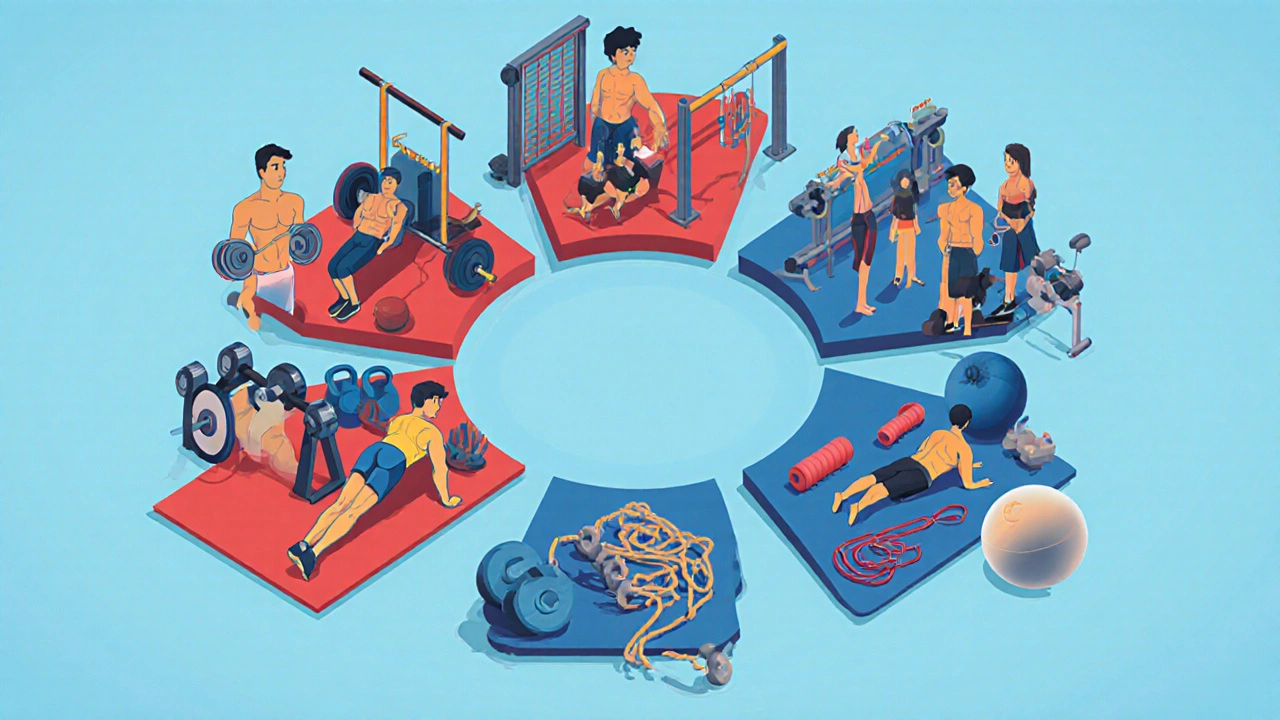7-Day Gym Routine Planner
Select Your Fitness Goal
Weekly Overview
Your plan balances with active recovery to optimize progress and prevent overtraining.
Recovery Focus
Daily Schedule
| Day | Focus Area | Intensity Level | Recovery Type |
|---|
Ever wonder if showing up at the gym every single day actually helps you reach your goals, or if it just burns you out? That question pops up a lot in fitness forums, especially when people hear success stories of “gym rats” who never miss a session. In this article we break down the science, weigh the pros and cons, and give you a roadmap to make a daily gym habit work without wrecking your body.
Key Takeaways
- Training 7 days a week can work for specific goals, but it requires careful programming.
- Without proper recovery, you risk overtraining, injuries, and stalled progress.
- Structuring sessions around muscle groups, intensity, and active recovery is essential.
- Sleep, nutrition, and stress management are non‑negotiable for daily training.
- Most people see better long‑term results with 4-6 gym days and at least one true rest day.
7‑day gym routine is a training schedule that slots a workout into every calendar day, often with varying focus areas to avoid hitting the same muscles back‑to‑back. The concept sounds appealing-more time in the gym means more calories burned, more strength gained, right? Not exactly. Your body needs time to repair the tiny tears that happen during each lift, and that repair process is what fuels growth.
Benefits of a Daily Gym Habit
When done correctly, hitting the gym every day can bring real advantages:
- Consistent habit formation: Daily action reduces the mental friction of deciding whether to work out.
- Higher total weekly volume: Splitting sessions into shorter, focused blocks can let you move more weight overall.
- Improved skill acquisition: Practicing a movement daily (e.g., Olympic lifts) speeds up motor learning.
- Better mood regulation: Regular exercise releases endorphins that combat stress.
But these perks only appear when you pair the workouts with optimal recovery.

Risks of Ignoring Recovery
The biggest pitfall of a 7 day gym routine is slipping into overtraining. Overtraining isn’t just feeling sore; it’s a chronic state where the nervous system, hormonal balance, and immune function are all taxed. Common signs include persistent fatigue, trouble sleeping, irritability, decreased performance, and frequent minor injuries.
Another hidden danger is muscle recovery getting cut short. Muscles typically need 48‑72 hours of rest after a heavy stimulus to fully rebuild. If you keep loading the same fibers day after day, you’ll see diminishing returns and possibly muscle breakdown (rhabdomyolysis in extreme cases).
Lastly, mental burnout can creep in. The excitement of a new routine can turn into a chore if you never give yourself a mental break.
How to Structure a Safe 7‑Day Gym Routine
Here’s a step‑by‑step blueprint that lets you train daily while keeping recovery in check:
- Identify your primary goal. Strength, hypertrophy, endurance, or skill? Your goal dictates intensity and volume.
- Choose a periodization model. Periodization is the practice of cycling training variables (load, reps, rest) over weeks. For daily training, a “undulating” or “daily‑split” model works well.
- Plan muscle‑group splits. Example schedule:
- Monday - Upper‑body push (chest, shoulders, triceps)
- Tuesday - Lower‑body quad‑dominant
- Wednesday - Upper‑body pull (back, biceps)
- Thursday - Lower‑body hamstring‑glute focus
- Friday - Full‑body functional / conditioning
- Saturday - Active recovery (mobility, light cardio)
- Sunday - Core & stability + mobility
- Manipulate intensity. Alternate heavy, moderate, and light days. Heavy days (80‑90% 1RM) should be followed by light technique or mobility sessions.
- Incorporate active recovery. Split training isn’t just about muscles-it includes low‑intensity cardio, foam rolling, or yoga to boost blood flow.
- Track sleep and nutrition. Aim for 7‑9 hours of sleep and ensure you’re eating enough protein (1.6‑2.2g per kg body weight) and calories to support the extra volume.
- Listen to your body. Use a simple daily wellness questionnaire: energy, soreness, mood, and sleep quality. Adjust the upcoming session if any score is low.
By rotating focus and intensity, you let each muscle group rest while still filling the calendar with gym time.
Signs You Need More Rest
Even with the best plan, you may hit a point where the body screams for a break. Watch for these red flags:
- Performance drops on lifts you used to crush.
- Joint pain that lingers beyond a day.
- Elevated resting heart rate (more than 5‑10bpm above baseline).
- Insomnia or restless sleep.
- Loss of appetite or gastrointestinal upset.
If two or more appear, schedule a full rest day or an easy‑recovery session (light stretching, walking). The short pause will usually translate into a rebound in strength within a week.

Alternatives to a Full 7‑Day Grind
For most hobbyists and busy professionals, a 4-6 day split provides a sweet spot between consistency and recovery. Here’s a quick comparison:
| Frequency | Typical Weekly Volume | Recovery Needs | Best For |
|---|---|---|---|
| 3 days (full‑body) | Low‑moderate | High - ample rest | Beginners, time‑crunched |
| 4‑5 days (upper/lower split) | Moderate‑high | Moderate | Intermediate lifters |
| 6 days (body‑part split) | High | Moderate‑low - need active recovery | Advanced hypertrophy focus |
| 7 days (daily variation) | Very high | Low - strict programming required | Elite athletes, specific skill work |
If you’re not an elite athlete, start with a 4‑day split and experiment with adding a light active‑recovery day before jumping to a full 7‑day schedule.
Putting It All Together
So, is a 7‑day gym routine good? The answer is “it can be, but only if you structure it like a professional program.” The key ingredients are:
- Clear goal and periodized plan.
- Balanced muscle‑group splits.
- Variable intensity and built‑in active recovery.
- Prioritizing sleep, nutrition, and stress management.
- Regular self‑monitoring to catch early signs of overtraining.
When those pieces click, daily gym sessions can boost skill acquisition and keep you in the habit loop. Miss one day occasionally, and you’ll still be on track-consistency over perfection wins the long game.
Frequently Asked Questions
Can beginners safely train seven days a week?
For most beginners, a 7‑day schedule is too much. Their bodies are still adapting to resistance training, so they need more rest. Start with 3‑4 days and focus on form before adding extra days.
What’s the difference between a rest day and an active‑recovery day?
A rest day means little to no structured activity-just sleep and normal movement. An active‑recovery day includes low‑intensity work like mobility drills, walking, or light cycling to increase blood flow without stressing the nervous system.
How much protein should I eat if I’m training daily?
Aim for 1.6‑2.2grams of protein per kilogram of body weight each day. Spread it across 3‑5 meals to maximize muscle protein synthesis after each workout.
Is cardio compatible with a 7‑day weight‑lifting schedule?
Yes, but keep cardio sessions low‑intensity on heavy lifting days. Reserve moderate‑to‑high‑intensity cardio for lighter or active‑recovery days to avoid excessive fatigue.
What are some quick signs I’m overtraining?
Persistent soreness, declining lift numbers, trouble sleeping, elevated resting heart rate, mood swings, and frequent minor illnesses are strong indicators you need more rest.
Should I adjust my routine if I travel often?
Travel disrupts sleep and nutrition, so scale back intensity. Focus on body‑weight circuits, stretch, and keep the habit alive with short, portable workouts.


